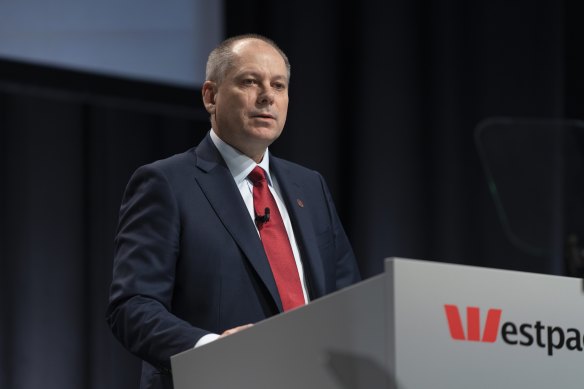Save articles for later
Add articles to your saved list and come back to them any time.
The mortgage cliff turned out to be a ditch and not a particularly precarious one – and the vast majority of Australian borrowers have not financially perished negotiating it.
Now more than halfway through the enormous Australian borrower refinancing from cheap fixed interest rates to pricey variable rates, the first of the major banks to report, Westpac, has now provided tangible evidence that those with a mortgage are still paying their interest bills.
Westpac chief Peter King says the bank had buffers to cushion it from a flood of delinquent loans.Credit: Eamon Gallagher
The rates of delinquency and arrears have risen on mortgages, but they are still below where they were a few years ago.
Rather than this being a sign that disaster has been averted, it’s evidence that the sky was never falling.
The danger period hasn’t completely passed. There is another lump of rollover activity hitting the current half of this calendar year, but it will ease significantly next year.
Westpac says it has 13,000 hardship cases – and while this is still a lot of people, the bank has 1.6 million mortgages, so proportionately it is tiny.
Historical patterns show people will cut their spending on just about everything else in order to make their interest payments.
None of the banks want to play down the stress and financial difficulties that some in the community are facing from higher interest rates and cost-of-living pressure. It doesn’t look good to deal with this issue purely on a statistical basis, so banks such as Westpac spend a disproportionate amount of time talking about the perils of the few.
But the bank has plenty of data to back up its view that most borrowers are managing. A large number have money in offset accounts (and that amount actually rose in the second half of Westpac’s financial year to September), and many are ahead on payments by several months.
This isn’t to say that those with a mortgage are having an easy time of it. But it does accord with historical patterns that show people will cut their spending on just about everything else to meet their interest payments.
It also holds with conventional wisdom that the biggest threat to credit quality of mortgage books is unemployment, which right now remains at record lows. Depending on which economist you speak with, it could increase to about 4.5 per cent next year. But this still isn’t dangerous territory for banks.
“If we can get away with modest increases in unemployment, and we support people through that period, that will be good for the country,” Westpac chief executive Peter King said on Monday.
“I get worried when we are talking unemployment of seven or eight [per cent] – we stress [test] at seven, eight, nine and 10 per cent when we stress the bank’s credit portfolios.”
On the face of it, Westpac posted a sizable profit bump in its 2023 financial year – up 26 per cent. And even after taking out the one-off non-recurring items that muddy the result, the 12 per cent improvement was laudable but in line with what that market was expecting.
Shareholders were even rewarded with higher dividends and a share buyback, neither of which point to a company that is particularly fearful of what’s ahead, and certainly not the behaviour of a bank fearful of a mortgage cliff.
King isn’t expressing a sigh of relief that the cliff has been averted because as far as he is concerned that analogy was overdone. He said Westpac – like the other major banks – had buffers that would cushion it from a flood of delinquent loans.
The ability of borrowers to adapt features heavily in how banks escaped the cliff. And it also explains why consumer spending is so weak.
To the extent that Westpac felt pressure on earnings, it came about in the second half of its financial year – the six months to the end of September.
These numbers paint a somewhat different picture. It was in this period that profits were down 20 per cent in the first half, in large part because of the position the bank took in the hotly competitive mortgage market.
And it showed through in the core interest rate margin, which fell from 1.9 per cent in the first half of 2023, to 1.84 per cent in the second half, and down to 1.81 per cent in the last month of that period.
The big four banks are facing their own cost pressures thanks to inflation.Credit: Ryan Stuart
Westpac was more aggressive than some competitors, particularly the Commonwealth Bank, and while it grew market share, the profitability of those mortgages came under pressure.
King bent himself into contortions to avoid revealing how hard (or not) it will compete in mortgages going forward.
He said he was now looking to retain market share (rather than grow it), which suggests more aggressive discounting such as cashbacks won’t be on the agenda.
The huge refinancing event that involved borrowers moving from fixed to variable rates was the trigger for the mortgage war as banks weaponised price to retain their customers.
Over the coming week we will learn how two of the other big banks, National Australia Bank and ANZ, have balanced market share against margins.
Neither are expected to report that hordes of their customers have fallen off a mortgage cliff.
The Business Briefing newsletter delivers major stories, exclusive coverage and expert opinion. Sign up to get it every weekday morning.
Most Viewed in Business
From our partners
Source: Read Full Article


